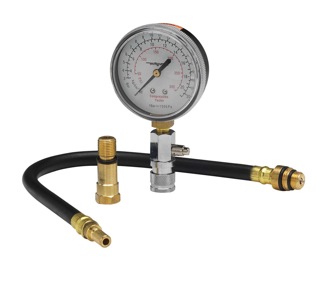Blog
What Is Engine Compression And How Is It Tested?

Any engine, whether gasoline or diesel, requires compression to operate. The process of compression confines and presses a mixture of air and fuel into a small volume within the area of the engine's cylinder. This process presses together all the molecules under very high pressure. Since the gasoline engine has a spark plug, only moderate compression is enough, requiring about 140-160 pounds per square inch (PSI). Depending on their size and application, some engines may require a higher compression such as 220 PSI. The manufacturer gives the exact compression factor. The compression process of the air-fuel mixture and its ignition is what produces the necessary power to operate a vehicle.
If the gasoline engine compresses its air-fuel mixture to a very high figure, it results in pre-ignition or detonation. This can be very destructive and cause damage to the internal parts of the engine. In the case of diesel engines, there is no spark plug, and the process of compression itself causes the diesel oil to ignite. As a result, the compression required in a diesel engine is very high, usually about 350 PSI or more. This makes the diesel engine much heavier and louder compared to the gasoline engines.
When Should You Check The Compression In Your Vehicle?
Generally speaking, if your engine is running rough or is not producing enough power, you should suspect the compression. Technicians and manufacturers also believe that every time a tune up is done as a part of preventive maintenance, the engine should be given a compression test. With a compression test, internal engine malfunctions, such as due to bad valves, excessive carbon build up, worn out piston rings, can be detected much before they can cause irreparable damage. Being aware of these problems, the owner benefits, as they can make an informed decision whether to sell the vehicle or to invest in repairs.
How Is Engine Compression Checked?
Vehicles require different ways for checking compression. Diesel engines require specialized equipment and an elaborate set up. Testing a gasoline engine is rather simpler. There are two general ways of testing the compression on a gasoline engine:
Method 1: The process involves the use of a manual, hand-held compression gauge
• The test must only be done on a properly warmed up engine; a cold engine will give erroneous results. Therefore, ensure the oil has warned up sufficiently before you begin the test.
• Disable the ignition coil or module.
• Remove one spark plug at a time and insert the compression tester into the hole at that cylinder.
• Allow the engine to get adequate air intake by holding the throttle to a fully open position.
• Let the engine crank continually for at least five to ten full revolutions as that will allow an accurate reading on the compression tester.
• Record the reading from each cylinder. No problem is indicated if any of the readings vary within or up to 10% from each other. No further testing may be necessary and the compression can be considered optimal.
• For a variance of more than 10%, full diagnosis of the problem may require specialized testing equipment.
Method 2: This method relies on the use of an electronic engine analyzer. The analyzer causes one cylinder at a time to be 'shorted', while the engine is running and calculates the drop in RPM. After all cylinders have been measured, the results show which cylinders are working the hardest and which are working the least. The cylinders showing higher compression are working harder compared to those showing lower compression.
For those who are testing compression as do it yourself, method 1 or the manual compression test is easier.
What Is The Consequence Of Too Low Or Too High Compression?
If you have found the compression results in your vehicle to be too high or too low, it is a good idea to consult a professional technician. Modern vehicles are very complicated and repairs based on do-it-yourself tests can be disastrous. However, the following give a general understanding of the reasons of compression deviating from the normal:
Consecutive Low Compression in All Cylinders
This could happen because of fuel washed cylinders, when too much fuel is introduced into the engine and all oil has been washed off the walls of the cylinder. The oil creates a sealing effect between the ring assemblies of the piston and the cylinder walls of the engine block. When this thin layer of oil is washed off, the engine compression escapes into the crankcase. Engines with a flooding problem usually show this behavior.
Low compression in all cylinders may also be caused by worn out piston rings and cylinder walls. The engine may seem to run normally, but not generate enough power and puff out small amounts of bluish smoke.
Use a small can of oil and squirt a small amount of oil into each cylinder. Repeat the compression test. If the compression improves dramatically, then you have found one or both the problems listed above. However, if there is no change in the compression test results, the engine may be facing a timing problem between the crankshaft and the camshaft of the engine. You may need to check the timing chain or belt for proper 'timing'.
Low or Zero Reading in One Cylinder
In this case, there is a high probability of internal engine damage, such as a broken connecting rod, a leaking or broken valve, a broken valve spring, a bent push rod or excessive camshaft wear.
Low or Zero Readings in Two Adjacent Cylinders
This usually happens if there is a blown or weak head gasket. Another possibility is a broken camshaft in the area that operates valves for two adjacent cylinders.
High Reading in One or More Cylinders
High compression readings are usually found on engines with excessive carbon buildup. The cylinder heads may have to be taken out and the carbon physically removed. The carbon attaches to the cylinder portion of the head and to the tops of the pistons. Severe cases may require the engine to be chemically de-carbonized.
overall rating:
my rating:
log in to rate

